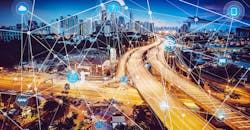The Smart Grid Has Its Moment
Opinion/Analysis
Happening in the first month of the Biden Administration, Texas’s massive electrical grid failure may have had one good outcome. Cascading effects of loss of power and heat, outrageous bills for the few who did have power, economic shutdown, flooding, fires, etc., provides the best argument possible for quickly developing the Smart Grid that would literally and figuratively power the president’s multi-trillion dollar infrastructure plan to revitalize the economy while reducing global warming.
Texas has experienced major economic growth in the past few years, drawn by the lower costs of living and less regulation. Companies including Hewlett-Packard and Oracle have announced plans to move their headquarters there. In 2020 alone more than 35 companies built new facilities or relocated to Austin.
However, that deregulation came at a staggering price, since Texas utilities were not required to winterize their grids or modernize equipment. When the deep freeze came, the state couldn’t call on resources of the Western regional grid, and the antiquated system quickly froze. Those companies drawn to Texas by deregulation’s benefits suffered from its own downside.
One of the first to call for enactment of the Biden Smart Grid—and to make it a public-private partnership—was Dow CEO Jim Fitterling, who told the Financial Times that … “ this is a little bit like the pandemic: you don’t waste the crisis, you use this to drill in.” Dow has major facilities in Texas, which were forced to close because of the electricity failure.
Fitterling went on to say the antiquated power grid is becoming a serious obstacle to US economic growth nationwide: ““Our electric grid is old, and although there have been a lot of investments in alternative energy, there hasn’t been a fundamental build to a better level of the electricity grid infrastructure, and that’s going to need to happen.”
Elsewhere, California’s massive and antiquated grid has played a major role in the global-warming induced wildfires that have plagued the state, He predicted the massive investment would be beyond government’s ability to pay — especially in the wake of COVID — so that the private sector would need to be partners in the project.
The Biden infrastructure plan integrates a wide range of priorities, including radically cutting greenhouse emissions, creating well-paying job growth in sectors such as clean energy and building electric vehicles, and rebuilding cities. The interdependence and synergies between the initiatives are calculated both to building a diverse political coalition favoring the plan, while also maximizing the economic and environmental benefits, rather than just spending to repair the existing, outmoded 20th-century infrastructure.
Smart Grids use the same digital communication that has transformed telecommunications, allowing real-time two-way communication between utilities and customers, electricity sources and the devices they power. They’re made possible in part by IoT, which adds sensors on transmission lines and on devices from assembly lines to homes, so they can report their status and power needs instantly.
They offer the promise of a total paradigm shift in electricity production and distribution, as Shuli Goodman, executive director at LF Energy told POWER magazine:
“The benefits are the ability to virtualize hardware and minimize the expense of proprietary solutions,” Goodman said. “… Smart grids are essential because they are moving us from a principally centralized, one-way system to a multi-directional mesh-like network with devices that can be both loads and resources to the grid. In essence, smart grid technology allows us to transform from a centralized paradigm into a distributed paradigm whereby we manage variable energy demand and generation, including electric mobility or batteries on wheels.”
That change will improve almost every aspect of the economy and environment. Among other benefits:
· Smart grids directly address the utility reliability issue by instantly alerting operators to the earliest stages of transmission and generation problems, when the issues can be corrected cheaply without widespread outages — often through automatic self-regulation. This will result in lower utility operating costs, leading to lower costs for users.
· They’re essential to integrating decentralized renewable sources such as photovoltaics (PV) and wind into the grid alongside the current massive centralized plants. Even electric vehicles may contribute to the energy supply if excess electricity they generate in motion is tapped by plugging the vehicle into the grid.
· They improve transmission efficiency and resilient, reducing the chance of “domino” effect blackouts over entire regions. In some cases, a city or neighborhood may develop its own smart “microgrid” of renewable sources that could still generate and distribute power in the area in case of a widespread blackout (Austin has one of the most well-developed microgrids. Because it has not been fully completed, it couldn’t detach from the Texas grid during the disaster, so the city was affected).
· Manufacturers can manage their electric use more intelligently and in real time because of a combination of smart metering and smart, self-regulating assembly-line machinery. Manufacturers can save on energy costs by switching some production to lower cost off-peak use. “Rolling blackouts” can be managed more efficiently and equitably because of real-time feedback about demand.
· They can stimulate sales for smart-home devices such as lighting or thermostats. Consumers can cut their utility bills by creating Home Area Networks (HANs) linking the devices, while letting the utility become more efficient by receiving real-time feedback on demand.
· They reduce global warming by reducing the need to fire up older, less-efficient “peaking” plants, while encouraging renewables. In the long run, smart grids are vital to encouraging growth of the electric vehicle market.
The Texas winter disaster, combined with the recurring wildfires in California attributed to a combination of winds from global warming and antiquated transmission lines dramatically illustrate the 20th-century electrical grid’s inadequacy for today. Smart grid technology is proven. The business community must rally behind federal funding to make it a reality and spark economic growth while simultaneously reducing global warming. Truly a win-win situation.
